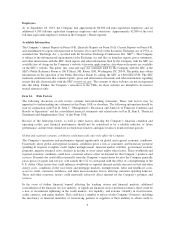Apple 2013 Annual Report Download - page 21
Download and view the complete annual report
Please find page 21 of the 2013 Apple annual report below. You can navigate through the pages in the report by either clicking on the pages listed below, or by using the keyword search tool below to find specific information within the annual report.expectations of future growth and profitability. The Company also believes its stock price reflects expectations
that its cash dividend will continue at current levels or grow and that its current share repurchase program will be
fully consummated. Future dividends are subject to declaration by the Company’s Board of Directors, and the
Company’s share repurchase program does not obligate it to acquire any specific number of shares. If the
Company fails to meet any of these expectations related to future growth, profitability, dividends, share
repurchases or other market expectations its stock price may decline significantly, which could have a material
adverse impact on investor confidence and employee retention.
The Company’s financial performance is subject to risks associated with changes in the value of the U.S. dollar
versus local currencies.
The Company’s primary exposure to movements in foreign currency exchange rates relates to non-U.S. dollar
denominated sales and operating expenses worldwide. Weakening of foreign currencies relative to the U.S. dollar
adversely affects the U.S. dollar value of the Company’s foreign currency-denominated sales and earnings, and
generally leads the Company to raise international pricing, potentially reducing demand for the Company’s
products. Margins on sales of the Company’s products in foreign countries, and on sales of products that include
components obtained from foreign suppliers, could be materially adversely affected by foreign currency
exchange rate fluctuations. In some circumstances, for competitive or other reasons, the Company may decide
not to raise local prices to fully offset the dollar’s strengthening, or at all, which would adversely affect the U.S.
dollar value of the Company’s foreign currency denominated sales and earnings. Conversely, a strengthening of
foreign currencies relative to the U.S. dollar, while generally beneficial to the Company’s foreign currency-
denominated sales and earnings, could cause the Company to reduce international pricing and incur losses on its
foreign currency derivative instruments, thereby limiting the benefit. Additionally, strengthening of foreign
currencies may also increase the Company’s cost of product components denominated in those currencies, thus
adversely affecting gross margins.
The Company uses derivative instruments, such as foreign currency forward and option contracts, to hedge
certain exposures to fluctuations in foreign currency exchange rates. The use of such hedging activities may not
offset any or more than a portion of the adverse financial effects of unfavorable movements in foreign exchange
rates over the limited time the hedges are in place.
The Company is exposed to credit risk and fluctuations in the market values of its investment portfolio.
Given the global nature of its business, the Company has both domestic and international investments. Credit
ratings and pricing of the Company’s investments can be negatively affected by liquidity, credit deterioration,
financial results, economic risk, political risk, sovereign risk or other factors. As a result, the value and liquidity
of the Company’s cash, cash equivalents and marketable securities may fluctuate substantially. Therefore,
although the Company has not realized any significant losses on its cash, cash equivalents and marketable
securities, future fluctuations in their value could result in a significant realized loss.
The Company is exposed to credit risk on its trade accounts receivable, vendor non-trade receivables and
prepayments related to long-term supply agreements, and this risk is heightened during periods when economic
conditions worsen.
The Company distributes its products through third-party cellular network carriers, wholesalers, retailers and
value-added resellers. A substantial majority of the Company’s outstanding trade receivables are not covered by
collateral or credit insurance. The Company’s exposure to credit and collectability risk on its trade receivables is
higher in certain international markets and its ability to mitigate such risks may be limited. The Company also
has unsecured vendor non-trade receivables resulting from purchases of components by outsourcing partners and
other vendors that manufacture sub-assemblies or assemble final products for the Company. In addition, the
Company has made prepayments associated with long-term supply agreements to secure supply of inventory
components. As of September 28, 2013, a significant portion of the Company’s trade receivables was
19
























